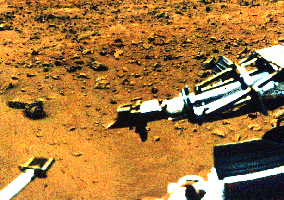




The
Viking Mars Mission Life Experiments
 |
||
|
While planning for the Viking Mars Missions in the early 1970's, NASA discussed a wide range of experiments for detecting life on Mars, including ones which would discover photosynthesis, proteins and enzymes. Finally they decided on using five different ways to detect carbon-based, oxygen-breathing, life. They were: Gas
Chromatograph Mass Spectrometer - this
experiment was intended to detect and identify organic molecules
in the Martian soil, such as formaldehydes, using the then
new science of mass spectroscopy. The
experiment did not detect any organic molecules which could have
indicated waste matter from living organisms. Gas Exchange Experiment - this would analyze gases, given off from Martian soil, to look for biological by-products. The soil sample was sealed in a container and the Martian atmosphere was replaced by inert helium gas. Then a fine liquid suspension containing nutrients (including ascorbic acid) was introduced and a number of gas samples were taken for chemical analysis. Variations in temperature, humidity, and incubation time were made to different samples and one was sterilized by heating. There
was a very rapid liberation of oxygen measured when the low humidity
variation was carried out, but this soon halted. The oxygen
reaction was not affected by heating to 145 C (293 F). Whether
it took place in the light or the dark made no difference to the
reaction. When samples were incubated for several months,
this too had no effect on the strength of the reaction.
After three days, the soil was soaked in water and the analysis
repeated. This time, a third of the carbon-dioxide
present was absorbed into the water and soil immediately, and
the oxygen level decreased. After incubation, the samples
slowly released carbon-dioxide until the original balance was
achieved and the reaction ceased. Labeled Release Experiment - this used tagging of the nutrients by radioactive carbon, in order to trace any absorption and subsequent excretion of them by living organisms. Martian soil samples were taken and sealed into containers with uncontaminated Martian air. Water vapor and radioactively-tagged nutrients were added to the samples and incubated for up to 52 sols (martian days). One of the samples was sterilized and two were heated to 50 C (122 F). The radioactivity being released from the soil was measured with a Geiger counter and the readings compared with control samples of Earth soil, under simulated Martian conditions. In
the unsterilized samples the rapid increase in radioactivity level,
followed by a leveling off, was the same as for the Earth soil.
When sterilized, the soil did not release any radioactivity, again
this was the same as for Earth soil. Heat treatment at 50
C (122 F) for a prolonged time reduced radioactivity detected
in both Martian and Earth situations. Pyrolytic Release Experiment - this experiment assumed that any life-form would need to breathe in carbon-dioxide gas from the atmosphere, to incorporate carbon into its own structure. It would detect carbon molecules that had been assimilated by the organisms. The sealed chamber containing Martian soil, was lit to simulate Martian day and night. Small quantities of radioactive carbon-dioxide and carbon-monoxide were introduced, in similar CO2 to CO proportions as Martian air. Again, water-vapor was used to stimulate growth. Samples were incubated for five days, at between 8 C (46 F) to 26 C (79 F), with simulated Martian days. Then radioactive gas was extracted from the chamber and the soil analyzed. This was done by heating the soil to 635 C (1175 F), to release carbon atoms from the incinerated organic compounds. The gases released from the burnt soil were then filtered and burnt to produce carbon-dioxide gas again, which was passed by a Geiger counter, so that radioactive carbon atoms could be counted. The results of seven, of the nine successfully carried out experiments, showed small peaks of radioactive carbon atoms. These readings could indicate a very low level of biological activity.
The Viking team did not find any evidence of biological activity from the images. |
||
Go
to
Home
| Space Station
| Mars | Rainforest
© 1999 Satellite Events Enterprises Inc.